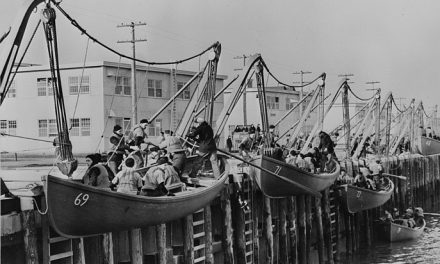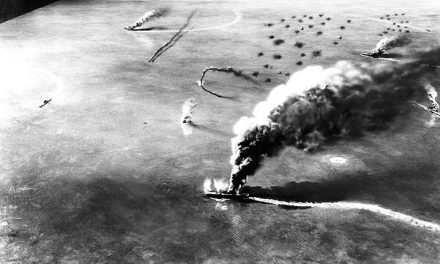The Tunisia Campaign in North Africa ended yesterday after six months of combat with the unconditional surrender of Axis powers at 8:15 p.m. Allied forces captured the German commander in chief Jurgen von Arnim, 11 other generals, and over 150,000 enemy troops.
The number of prisoners has been climbing since Axis forces began surrendering on May 5, said an official press release. It is expected to climb even higher in the coming days. Out of the 150,000 captives, it is estimated that about 110,000 are Germans and the remainder Italians. American forces have taken 25,000 prisoners, including 6 of the 12 generals captured, in their northern sector of the Tunisia front.
The French have also reported the capture of two generals, named Yelich and Pfeiffer. Between the two, the French captured over 25,000 Axis troops, including the Italian Superba Division. Although the Italian First Army still fights on, their general Giovanni Messe is due for capture soon.
Commander in Chief General Dwight D. Eisenhower motivated the troops, declaring, “As long as a single armed German is on African soil, there is still a battle and I want to destroy the rest of his resistance.”
The defeat, which took place in Northern Tunisia, was swift and relentless. Remaining Axis forces split up in desperate attempts to flee. Von Arnim and his men took to the Cap Bon Peninsula, hoping to escape to Sicily, but were cut off by a deadly British air-sea blockade, where they surrendered almost without opposition. American forces, several miles below the peninsula, set up blockades where groups attempting to leave the peninsula were blocked.
The prisoners were rounded up into an enormous bull pen in a Tunisian wheat field to be counted and fed before they were moved. Isolated groups of resistance are still active in a 9-mile circle in the Zaghouan Mountains, but the campaign is considered to be nearly over and it is believed that the remaining resistance will soon be overrun. The French infantry has already deeply penetrated Djebel Zaghouan, the highest mountain in Tunisia, and advanced four miles towards the circle.
The quantity of military equipment captured from Axis forces is huge: hundreds of vehicles, such as armored cars, trucks, and tanks, along with hundreds of thousands of guns.
A captured Nazi order, dated April 18, revealed that dissatisfaction had been spreading among German troops in Tunisia, so much so that Nazi headquarters issued a threat of reprisal. Any relative of soldiers who surrendered “without due cause,” and the men themselves after the war, were to be punished. From the document, it can be asserted that noncommissioned officers leading platoons had encouraged their men to surrender, although their situations were not hopeless.Visit Site

Allied troops enter Tunis, the capital of Tunisia, May 1943. Photo by Nick Parrino, from Library of Congress.
Despite this threat, numbers of Axis surrenders continue to rise. Allied forces, demanding unconditional surrender and the immediate delivery of all materials, have had their desires met. Outside of the circle in the Zaghouan Mountains, it is unclear how many Nazi forces are left, but British forces have been performing wide sweeps on both sides of the range, rounding up over 20,000 prisoners.
The Tunisia Campaign took up after Operation Torch ended on November 11, 1942. Operation Torch, the invasion of Vichy French-held North Africa, was a success that ended with the cessation of armed resistance in Morocco and Algeria. Following this, the Tunisia Campaign started, the advance into Tunisia, which would allow Allied forces to cross into Europe and invade Sicily.
Since the North Africa campaign began two years ago, 11 German divisions and 26 Italian divisions have been destroyed. Over 400,000 total Axis prisoners have been captured. There are no official figures of Allied losses during the campaign as of yet, but it is projected that losses will be relatively light.
Sources:
Kluckhohn, Frank. “AFRICAN WAR OVER: 100,000 of Captive Total Believed German.” New York Times. May 13, 1943. Pg 1.
“Story of German Surrender; Berliners Stunned by News: The War Today Can’t Believe It.” The Washington Post. May 11, 1943. Pg 1.
Kennedy, Edward. “11 Other Generals Captured; Vast Quantities of Material Seized in Final Allied Drive; Axis Prisoners Total 400,000: All French Africa Now in Allied Hands.” The Washington Post. May 13, 1943. Pg 1.
“ENEMY CASUALITIES IN TUNISIA 324,000: 267,000 Captured, 30,000 Killed and 27,000 Wounded Since Start of Campaign.” The New York Times. May 20, 1943. Pg 5.
Boyle, Harold. “Prisoners Stream In: Story of Germans’ Africa Surrender.” The Washington Post. May 11, 1943. Pg 1.
“NAZIS TO PUNISH KIN OF TROOPS WHO QUIT: Order Captured in Tunisia Also Threatens Reprisals on Soldiers Themselves.” The New York Times. May 5, 1943. Pg 3.
King, William. “British Armor Forces Race Up Both Sides of Peninsula: 20,000 More Nazi Troops Surrender.” The Washington Post. May 12, 1943. Pg 1.






Interesting concept. I especially like the young lady citing her sources. I’m nosy to know what grade she got for this.
Thank god that horrible desert front is gone!